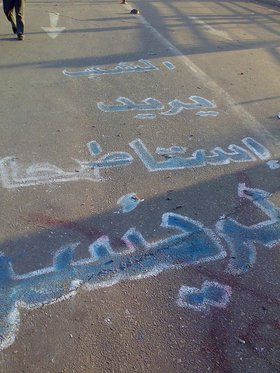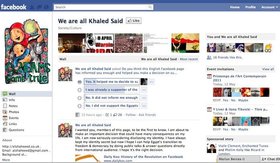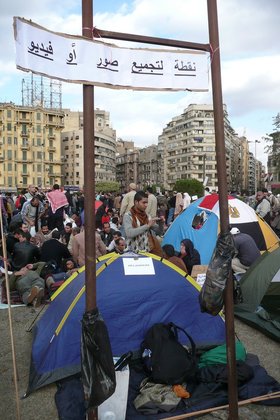Essays
Understanding the Threat to Arab Youth Uprisings
Facebook, Twitter, blogs, graffiti, videos, and songs – all have contributed to recent events in the Middle East. While it is difficult to gauge the exact extent of the actual influence of social networking in these upheavals, it is generally considered that it has been one of the pivotal elements in the organization of youth movements and protests throughout the region.
However, and although we cannot appeal to one factor in explaining the emergence and durability of social networking, Joe F. Khalil suggests here that although groups of young people articulated a cultural politics that remains distinct from the socio-political spheres that rejected them this does not mean that the mass media has not attempted to co-opt both them and their message. It is in relation to the latter that Khalil notes a disturbing gulf between mainstream media's characterization of young people's activities and what young people themselves are expressing through their own media.
Since 2006, I have travelled to Egypt, Jordan, Lebanon, Dubai, Saudi Arabia and Syria examining what I call youth-generated media – the types made famous in connection with protests in Tunisia, Egypt and elsewhere in the Arab world. These include but are not restricted to Facebook, Twitter, blogs, graffiti, videos, songs and other forms of communication developed and circulated by young people with or without the support of adults.
These online and offline youth-generated media are conduits for social networks defined as groups of individuals connected by one or various levels of interdependencies (age, politics, economics etc.). While Facebook and Twitter foster a community of like-minded individuals, other groups are linked through repeating political songs/chants or through messages sprayed by graffiti activists outside their 'neighbourhoods'.
Historically, Arab youth have been at the core of various types of social and political activism in the Arab world. Throughout the last century, each young generation fought grassroots, anti-establishment battles. The youth were the ideologues and fighters for liberation and independence movements in the Levant and Maghreb. In Lebanon, Egypt, Palestine and Algeria they were also the journalists, poets and singers using newspapers, booklets and oral traditions to spread the message. Later in the century, young people were the driving force behind urban mass protests (Egypt), organized labour (Tunisia), social and political Islam (Bahrain, Syria, Saudi Arabia). Consequently, forms of alternative media were used including forms of graffiti, posters, flyers, political theatre, songs and poetry. These youth-generated media acted in opposition to mainstream regime controlled mass media.
While we cannot appeal to one factor in explaining the emergence and durability of such youth movements, it is important to highlight the role of youth activism. Here, we ought to be concerned with how groups of young people are involved in actions to make heard their alternative voices within a dominant mainstream environment. The notion of youth activism has an evocative rhetoric which embodies so many of our desires for the good of the society. As with many objects of desire, closer inspection can generate complications; nevertheless, I argue that activism has a central role in characterizing some youth actions. The most visible of these actions are undoubtedly street demonstrations but another equally important manifestation of activism is youth-generated media.
Have no illusions, what we are seeing unfold in the Arab world reflects that in structure, content and impact, youth-generated media have articulated cultural politics distinct from both the socio-political regimes that ultimately rejected them and mass media that eventually co-opts them. It is a paradox, however, that so little attention has been dedicated to young people's cultural politics, given that they are the majority demographic group. Always spoken for and rarely speaking, young people's public space was restricted to religious or sports activities. A preliminary foray into this terrain should explore how youth-generated media are structurally egalitarian and democratizing. A further question on youth-generated media has to eventually address their de-territorial and multi-territorial reach and impact.
In examining wide-ranging cases of youth-generated media, I have identified four characteristics. The first relates to creativity, whereby the end result is a unique byproduct of young people's experiences. With youth-generated media, creative attributes are irrelevant to the extent that young people do not follow the market logic as present in mainstream media. When Tunisian rap artist, El Général, released the highly critical Rais Lebled as a song recorded and filmed in December 2010, it was a challenge to the conventional market wisdom of praising the president and glorifying his rule.Instead El Général chose to address the president, asking him to 'look at what is happening, miseries everywhere' and in a direct challenge to authority, he announced that he will 'talk with no fear, although I know I will only get troubles'. By the time the secret police realized the threat of such calls, it was too late: the song went viral and street protestors were already shouting it.
The second concerns young people's ability to render this creativity in a physical shape: an artefact. The latter is self-expressive of individual or collective experiences. Even simple acts can attract attention despite of media and collective action blackout. For example, the youth of the 14 February Revolution in Bahrain used the worldwide interest in Formula One sports to urge the organizers to refrain from reinstating the postponed race until their plights were met. They wrote an open letter and circulated it within traditional media but also used mailing lists, chat rooms and Facebook pages to target influential public opinion.
The third characteristic suggests the origination of forms of energy as young people are self-invested in their artefacts. To clarify, the term 'generated' accounts for the intensity and passion that often motivates young people to develop and circulate specific artefacts. For days and nights, young people converging on Cairo's Tahrir Square were invested in the development and circulation of banners, placards, costumes, signs, graffiti and performative acts. This energy initiated the mobilization of crowds, whether through social networks developed around Kolona Khaled Said('We are allKhaled Said') Facebook group or those formed in Zamalek neighbourhoods.
The fourth characteristic accounts for the ripple effect of youth-generated media which are, in many cases, part of a sequence of activities. The artefact is usually one element in a chain of events that combine media with other forms of youth cultural politics. From online to the streets, Egyptian Ahmed Khalil took his campaign message of post-revolution civic awareness from Facebook posts to flyers and leaflets.
A good reminder is due: youth-generated media fall at the intersection of a variety of adult interests – a developmental approach, or youth based politics – an organic approach. Consequently, any analysis of these media should not stop at describing their characteristics but should investigate levels of youth involvement.
As the means of producing and distributing media becomes cheaper, smaller and more accessible, Arab youth are appropriating these tools to produce messages in non-traditional forms. Youth-generated media are not only a display of creative genius or energy but they communicate youth cultural politics and moreby promoting ideas, placating opponents, articulating identities, acting in and reacting to everyday life. While, not surprisingly, this is the case of young people from Washington to Jakarta, young Arabs have deployed these tools, their creative talents and energy to develop messages that express their anxieties and experiences, articulating their hopes for a better future. Just like young people in Seattle's anti-globalization protest in 1999 and before them the French university students in 1968, young Arabs are articulating a political voice that roars against the violation of their rights as citizens.
The point that I want to emphasize here is a simple one: there is a distinctly disturbing gulf between mainstream media's characterization of young people's activities and what young people themselves are expressing through their media.
Looking back at his tenure as president of the Students for a Democratic Society (SDS) in the United States, sociologist Todd Gitlin, now a university professor, realized something fundamental about the relationship between youth movements, like the SDS, and mainstream media: in their attempt to use mass media, such movements end up losing control of their own image. Similarly, the May 1968 student revolt in France was framed as an anarchist movement that challenged the conservative ideals of patriotism, religion and respect for authority. At the time, mainstream media controlled by the government succeeded in shifting the debate from a struggle for basic rights to one about sexual liberation motivated by a mob of brainless communists, as they were described. In 1989, Chinese students calling for economic and political reforms led a series of demonstrations erupting in and around Beijing's Tiananmen Square. While non-Chinese media's reporting was mostly sympathetic to the movements, national media described the young Chinese as being manipulated by 'Black Hands' – secret groups organized to enact terrorism, allegedly financed and trained by Western governments. These examples point to the often purposefully distorted interpretation of young people's actions.
The series of Arab youth uprisings are far from over, and it is premature to suggest definitive lessons. It remains to be seen whether, in the long run, they are able to regain control over their narrative. But, in the short run, mainstream media is increasingly tightening the frame: on one hand, youth are celebrated as icons of the nations' future; on the other hand, they are forced to fit into particular frames of politicians, leaders, party members.
The writings are on the wall: a news presenter asking a demonstrator 'why can't you appoint a spokesperson? We don't want to be chasing you around', and another asking a media-proclaimed youth leader, 'would you consider running for office?', and a third reporter advising young protestors that 'they need to organize, perhaps develop a political party'. Well-established news channels, Al Jazeera and Al Arabiya could not resist the impulse to develop such traditional narratives of young people's activities. Such limited and limiting narratives were promoted by the media and largely internalized by youth movement leaders.
Because young people's uncontrolled dissent and increased public visibility is equal to a statement of power, political elites, columnists, sociologists, police and those with commercial interests cast their own definitions and interpretations of what was politically pragmatic in Lebanon's Cedar Revolution; what fit acceptable news frames during Tunisia's Jasmine Revolution; what is morally putative in the case of Bahrain's demonstrations and what is commercially viable in the case of 'an all Egypt all the time' news coverage.
In assessing the outcome of young people's self-expressive artefacts, we need to avoid the temptation of merely celebrating 'alternative visions', and pay closer attention to how Arab regimes resist threats, encroach on 'spaces' and muffle 'voices'. Identifying such practices requires analysing when and how increased visibility, as a result of media development, was co-opted, such as in the case of Lebanon, reframed in Tunis, harassed in Egypt, and mainstreamed in Bahrain.
I urge rethinking about the direct and indirect links between Arab regimes, private investors and the establishment of youth-oriented media platforms ‒ the political economy of Arab media. In television alone, the recent events have demonstrated the irrelevance of state media, which never operated in the public's interest, but revealed the overall restrictive policies of censorship, formulaic news and a scarcity of innovative programming. Private television channels are not necessarily independent from political regimes. Through myriad schemes, theylicensed, financed or partnered with private channels. The expectation is that the 'party line'will be maintained in times of crisis. In Egypt, Tunisia and elsewhere in the region, private channels, such as Al Mehwar or Nessma,were late to display any signs of independence let alone sympathy with the revolutions. Occasionally, some high profile television personalities would express dissent, only to find themselves stripped of their media platform.
One theme emerges from the above observations. It seems very plausible overall to regard the rise of youth-generated media as technologically determined, politically provoked, socially aggravated, economically driven, culturally activated, or at the very least personally stimulated. Across the Arab world, a compelling impulse common to all youth-generated media emerges, one that has media makers reacting to deeply rooted anxieties and uncertainties about the changes surrounding their everyday lives. Youth-generated media serve as catalysts for change, providing alternative vistas for political and social criticism.
To recapitulate: institutions of power, including state and media, are impaired not only because youth-generated media are simultaneously using 'alternative' channels of distributions and reflecting a globalized, networked and culturally sensitized youth, but also because state and media are increasingly dependent on forms of youth-generated media to mitigate dissent – the problem is one of control, not of communication.








